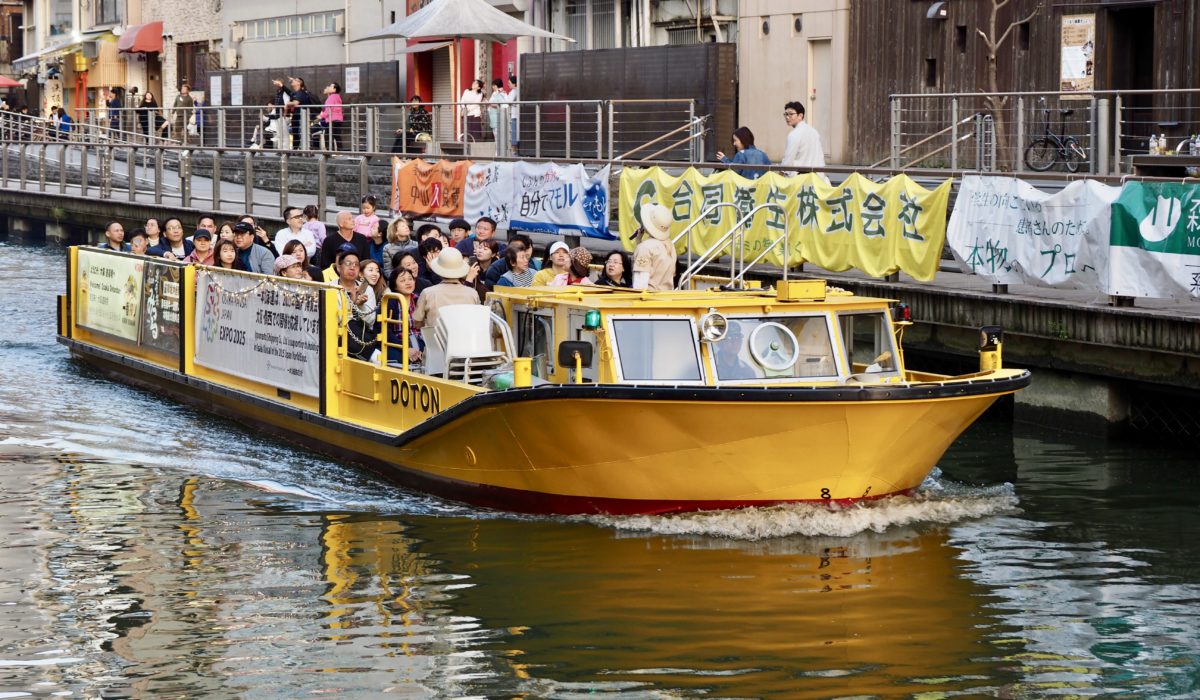Osaka was on our itinerary a year ago on a trip to Japan, but I didn’t do any research about what to see or do there. Fortunately Andy Bender, a tour guide and planner with Espirit Travel &Tours, gave us a couple of suggestions that turned out to be fabulous.
The large city in the middle of the country was our last destination on a three week whirlwind trip that encompassed artists, museums, temples, gardens and many fascinating experiences. Frankly, by the time we got to Osaka, I was a bit burned out from our go-go schedule.
We checked into the hotel—a large nondescript international hotel, not the kind I usually pick. I tend to like small locally owned boutique hotels but this was ok. Actually a good choice. Easy. Lots of people spoke English and as I was pretty weary of the struggle of trying to make myself understood it was fine.
Dotonbori
We headed off to Andy’s first recommendation-an area called Dotonbori. As I think back about this area, Times Square and San Antonio come to mind. I think of Times Square for the wall to wall video screens and San Antonio for the river walk, although on a much smaller scale.
It is one of Osaka‘s most popular tourist destinations for shopping, eating and amusements, running parallel to the Dotonbori Canal.
At night it is lit by hundreds of neon lights and mechanized signs, including the famous Glico Running Man sign.
We walked up one side of the river and down the other, observing Asian and Western tourists enjoying restaurants, shops, river boat tours, all under the watch fun eye of famous Glico Man.
According to Wikkipedia this sign, originally installed in 1935, depicting a giant athlete on a blue track, is a symbol of Glico candy. The sign has been altered on several occasions to celebrate events such as the World Cup and to show support for the Osaka baseball team, the Hanshin Tigers. The current version is the sixth, which uses LEDs. [4]
Whew. Really different experience than serene temples and rock gardens. I was ready for it.
Doguyasuji Shotengai
The other really fun thing we did was meander the 150 meter long shopping arcade dedicated to cookware, kitchen utensils and restaurant supplies. Dazzling.
Andy, who does culinary tours for Espirit, knowing we’re fascinated with Japanese food, suggested we visit the arcade called Doguyasuji Shotengai. Osaka sometimes called “Kitchen of the World” because so many chefs train and work there. The arcade was built in 1970 as a result.
Kitchen of the World
What fun it was to visit the 50 or so shops, looking at all the chef knives, lacquer bowls, chopsticks and bizarre plastic food samples. I couldn’t resist buying some cute little serving spoons and spreaders that would fit into my already bulging suitcase. I would have loved to have purchased more.
My husband imagined how wonderful it would be to have an apartment in Osaka and outfit the kitchen from this resource.




There are also shops that sell signboards, uniforms for the service crews of restaurants and huge utensils like the one my husband is holding. .
As we were leaving Osaka the next day, I noticed this man hole cover and a very fashionable woman. Soooo Japanese.
Interested in more about Japan. Here are links to blog posts.
Japanese Gardens Calm the Mind
Tea ceremony. Zen Buddhism in a Cup
Renting costumes flourishes in Japan and Korea
Naoshima Island-An Art Encounter
Cats: If you like cats, head to Japan
Plastic Food in Japan
Curious about the plastic food? I was. I googled and this is what I learned:
Plastic food makes Japan a lot of money — the country’s fake food industry is worth approximately $90 million. Hyper-realistic food samples, or “sampuru,” are handcrafted by skilled artisans and displayed in restaurant windows, movies, souvenir shops, and even classrooms.
As mass tourism has exploded in Japan, sampuru has served as an invaluable tool for foreigners across language barriers. Even if they don’t know any Japanese, they can just point at what they want to eat.





















